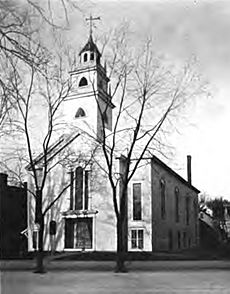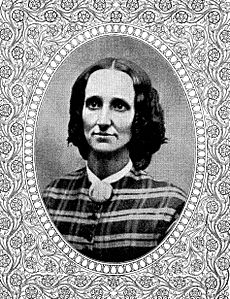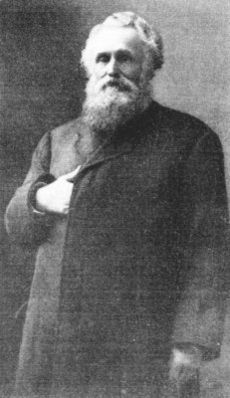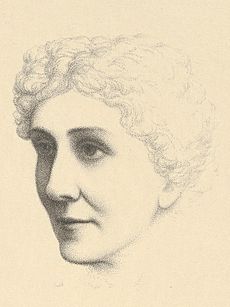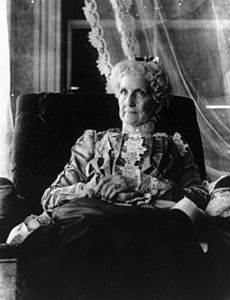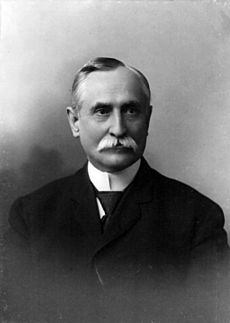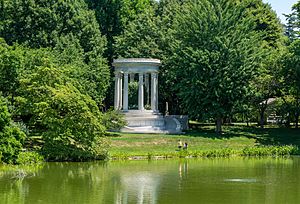Mary Baker Eddy facts for kids
Quick facts for kids
Mary Baker Eddy
|
|
|---|---|
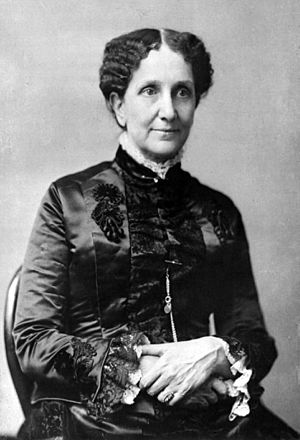 |
|
| Born |
Mary Morse Baker
July 16, 1821 Bow, New Hampshire, U.S.
|
| Died | December 3, 1910 (aged 89) Newton, Massachusetts, U.S.
|
| Resting place | Mount Auburn Cemetery, Cambridge, Massachusetts |
| Other names | Mary Baker Glover, Mary Patterson, Mary Baker Glover Eddy, Mary Baker G. Eddy |
| Known for | Founder of Christian Science |
|
Notable work
|
Science and Health (1875) |
| Spouse(s) |
George Washington Glover
(m. 1843; div. 1844)Daniel Patterson
(m. 1853; div. 1873)Asa Gilbert Eddy
(m. 1877; died 1882) |
| Children | George Washington Glover II |
| Parent(s) | Mark Baker (father) Abigail Ambrose Baker (mother) |
Mary Baker Eddy (born Mary Morse Baker; July 16, 1821 – December 3, 1910) was an American religious leader and author. She is famous for founding The Church of Christ, Scientist in New England in 1879.
She also started The Christian Science Monitor in 1908. This newspaper won a Pulitzer Prize. Mary Baker Eddy also created three religious magazines: the Christian Science Sentinel, The Christian Science Journal, and The Herald of Christian Science.
She wrote many books and articles. Her most famous book is Science and Health with Key to the Scriptures. By 2001, over nine million copies of this book had been sold.
People who follow Christian Science call Eddy the "discoverer" of their faith. They are known as Christian Scientists. In 2014, Smithsonian Magazine named her one of the "100 Most Significant Americans of All Time." Her book Science and Health was also listed as one of the "75 Books by Women Whose Words Have Changed the World." This recognition came from the Women's National Book Association.
Contents
Mary Baker Eddy's Early Life
Growing up in New Hampshire
Her Family

Mary Morse Baker was born in a farmhouse in Bow, New Hampshire. Her father, Mark Baker, was a farmer. Her mother was Abigail Barnard Baker. Mary was the youngest of their six children. She had three older brothers and two older sisters.
Her father, Mark Baker, was a very religious man. He came from a Protestant Congregationalist background. He was known for being quite strong-willed. Mary Baker Eddy said her father was an avid reader. He had also been a justice of the peace and a chaplain.
People in the area described him as having a strong temper. McClure's magazine once said he supported slavery. However, Eddy said her father believed in States' rights and saw slavery as a great sin. The Baker children were said to have inherited their father's strong will. Mary became known as the village beauty. Life was simple and involved a lot of hard work. Each day began with long prayers.
Her Health
Mary and her father often had a difficult relationship. Some stories say her father tried to control her will with strict rules. Her mother, however, was described as kind and quiet. Mary often became sick suddenly. Some thought this might have been a way to deal with her father. People who knew the family said she would sometimes fall to the floor. She would writhe and scream, or become silent for hours.
Historian Gillian Gill wrote that Mary was often sick as a child. She may have had an eating disorder. But reports about her "fits" might have been exaggerated. Eddy herself wrote about her food problems in her first book. She said she had chronic indigestion as a child. To cure it, she ate only water, bread, and vegetables. Sometimes, she ate only once a day. She described her early years as full of "hunger, pain, weakness, and starvation."
Mary was often unwell for much of her life. This continued until she discovered Christian Science. She wrote in her autobiography about her search for a remedy. She said she had a deep "hunger and thirst after divine things." She wanted "something higher and better than matter." She sought "the knowledge of God as the one great and ever-present relief from human woe." She tried many different healing methods. These included homeopathy and hydropathy, but nothing brought her lasting relief.
Moving to Tilton
Around age 14 or 15, Mary moved with her family to Sanbornton Bridge, New Hampshire. This town was later renamed Tilton in 1869.
At first, Mary could not attend Sanbornton Academy. She had to go to the district school. She left after a month due to poor health. She then received private lessons from Reverend Enoch Corser. She finally entered Sanbornton Academy in 1842.
She joined the Congregational church in Tilton on July 26, 1838. She was 17 years old at the time. Eddy later wrote that she was 12 when this happened. She said she discussed predestination with the pastor. She later admitted she might have been mistaken about the date.
Marriage and Widowhood
Mary Baker Eddy faced several sad losses in the 1840s. Her brother Albert, whom she saw as a teacher, died in 1841. In 1844, her first husband, George Washington Glover, died. They had been married for only six months. He died of yellow fever in June 1844. Mary was six months pregnant at the time.
She had to travel 1,400 miles back to New Hampshire. Her only child, George Washington II, was born there on September 12. The journey and birth left her very tired. She was bedridden for months. She tried to earn money by writing articles. She also worked as a substitute teacher and ran a kindergarten. She reportedly refused to use corporal punishment with the children.
Her mother died in November 1849. Mary was very sad, writing, "What is left of earth to me!" Three weeks later, her fiancé, John Bartlett, also died. In 1850, her four-year-old son was sent away. He was cared for by the family's nurse. It was hard for women in her situation to earn money. Also, women could not be their own children's guardians if their husbands died.
Her father remarried in 1850. His new wife had some property and income. Mary's father made it clear that her son would not be welcome in their new home. George was sent to live with different relatives. Mary decided to live with her sister Abigail. Abigail also did not take George.
Mary married again in 1853. Her second husband, Daniel Patterson, was a dentist. He said he would become George's legal guardian. But he did not follow through. Mary lost contact with her son when his caregivers moved to Minnesota. Later, her son joined the Union army during the Civil War.
Learning with Phineas Quimby
Mesmerism was popular in New England. In 1861, Mary's husband, Dr. Patterson, wrote to mesmerist Phineas Parkhurst Quimby. Quimby was known for curing people without medicine. Quimby said he could treat Mary if she came to him. Mary first tried a water cure, but her health got worse.
In October 1862, Mary visited Quimby. Her health improved a lot. She said she could walk up 182 steps to a city hall dome after a week. However, these cures were only temporary. Mary often became sick again.
Mary saw religious meaning in Quimby's healing. She believed it was like the healing Christ performed. From 1862 to 1865, she discussed healing methods with Quimby. She took notes on her own ideas. She also wrote down his ideas and added her own thoughts. Quimby was not very religious. But he accepted the religious ideas Mary brought to his work. He knew his religious patients would like it.
Phineas Quimby died on January 16, 1866. Mary Baker Eddy's father also died around this time.
Some people later claimed that Mary Baker Eddy copied Quimby's ideas. Quimby wrote many notes. Some of his original writings are in the Library of Congress. But many of his notes were edited by others. Quimby's son, George, did not like Eddy. He kept his father's writings hidden for a long time. In 1921, Julius Dresser's son, Horatio Dresser, published some writings. He called them The Quimby Manuscripts to support claims against Eddy. But he left out papers that did not fit his view.
Historian Gillian Gill noted that Quimby's own letters show he struggled with spelling and writing simple sentences. This makes it hard to prove he wrote many of the texts attributed to him. Also, the dates on some papers seem to be guesses made years later.
J. Gordon Melton said that Eddy shared some ideas with Quimby. But she also had different ideas, especially about healing methods. He added that she did not share Quimby's dislike for the Bible and Christianity.
The Fall in Lynn
In 1866, Mary Baker Eddy had a serious fall on ice in Lynn, Massachusetts. She was badly injured. Newspapers at the time reported her condition as very serious. One paper said, "It is feared she will not recover." Another said her injuries were "internal" and she was in a "very critical condition."
Mary later tried to claim money from the city of Lynn for her injury. She said she was "still suffering from the effects of that fall." She later dropped the lawsuit. Her neighbors were amazed by her quick recovery. They saw it as almost a miracle.
Mary Baker Eddy wrote in her autobiography, Retrospection and Introspection, about this time. She said she spent the next three years studying the Bible. She believed this led to her discovery of Christian Science. She wrote that she "withdrew from society about three years." She wanted to "ponder my mission, to search the Scriptures." She sought to "find the Science of Mind" that would show God's healing power.
Spiritualism
Mary Baker Eddy separated from her second husband, Daniel Patterson. She then lived with several families for four years. These families were in Lynn, Amesbury, and other places.
After she became well known, some reports said she had been a medium in Boston. A medium is someone who claims to talk to spirits. According to Gillian Gill, Eddy knew spiritualists and took part in some of their activities. But she was never a strong believer. For example, she visited her friend Sarah Crosby in 1864. Crosby believed in Spiritualism. Eddy reportedly tried to show Crosby that it was not real. She pretended to channel her dead brother Albert and wrote letters from him.
Some historians believe Eddy was working as a spiritualist medium. They say she was convinced by the messages. In one of her trances, Eddy gave a message supporting Phineas Quimby. She said, "P. Quimby of Portland has the spiritual truth of diseases. You must imbibe it to be healed." This part was later removed from an official biography of Eddy.
Between 1866 and 1870, Eddy lived with Brene Paine Clark. Clark was interested in Spiritualism. They often had lively discussions about it. Eddy's arguments against Spiritualism convinced some people. One person, Hiram Crafts, said her "science was far superior to spirit teachings." Clark's son tried to get Eddy to become a spiritualist. But he said she hated the idea.
Mary Gould, a Spiritualist, claimed Eddy channeled the spirit of Abraham Lincoln. Eyewitnesses said Eddy attended séances as late as 1872. In these later séances, she tried to get people to accept Christian Science. Eddy knew a lot about Spiritualist practices. But she spoke out against it in her Christian Science writings. Historian Ann Braude noted similarities between Spiritualism and Christian Science. But Eddy later believed that spirits never had bodies. This was because she taught that matter is not real. She believed only spirit truly exists, both before and after death.
Divorce and Publishing Her Work
Mary Baker Eddy divorced Daniel Patterson in 1873. After several years of teaching her healing method, she published her work. In 1875, she released a book called Science and Health. Years later, it was renamed Science and Health with Key to the Scriptures. She called it the textbook of Christian Science.
She published the first 1,000 copies herself. During these years, she taught what she called the science of "primitive Christianity." She taught at least 800 people. Many of her students became healers themselves. The last 100 pages of Science and Health have stories from people. They claimed to have been healed by reading her book. She made many changes to her book over the years. She continued revising it until shortly before she died.
Marriage to Asa Gilbert Eddy
On January 1, 1877, she married Asa Gilbert Eddy. She then became Mary Baker Eddy. The ceremony was small and led by a Unitarian minister. In 1881, Mary Baker Eddy started the Massachusetts Metaphysical College. This college could grant degrees. In 1882, the Eddys moved to Boston. Asa Gilbert Eddy died that same year.
Building a Church
Mary Baker Eddy spent the rest of her life building her church. She wrote its rules, called The Manual of The Mother Church. She also kept revising Science and Health. By the 1870s, she told her students, "Some day I will have a church of my own."
In 1879, she and her students started the Church of Christ, Scientist. Its goal was "to commemorate the word and works of our Master [Jesus]." It aimed to bring back "primitive Christianity and its lost element of healing." In 1892, the church was reorganized as The First Church of Christ, Scientist. It was "designed to be built on the Rock, Christ."
In 1881, she founded the Massachusetts Metaphysical College. She taught about 800 students there between 1882 and 1889. She charged $300 for tuition, which was a lot of money back then. Her students spread across the country. They practiced healing and taught others. Eddy allowed these students to be listed as Christian Science Practitioners. They were listed in the church's magazine, The Christian Science Journal. She also founded the Christian Science Sentinel, a weekly magazine. It had articles about healing and stories of healing.
In 1888, a reading room opened in Boston. It sold Bibles, her writings, and other publications. This idea spread. Today, there are over 1,200 Christian Science Reading Rooms worldwide. In 1894, the main church building, The Mother Church, was finished in Boston. In the early years, Eddy served as its pastor. In 1895, she named the Bible and Science and Health as the church's pastor.
Eddy founded The Christian Science Publishing Society in 1898. This became the publishing house for many of her publications. In 1908, at age 87, she started The Christian Science Monitor. This is a daily newspaper. She also founded the Christian Science Journal in 1883. This is a monthly magazine for church members. In 1898, she started the Christian Science Sentinel. This is a weekly religious magazine for a wider audience. She also created the Herald of Christian Science, a religious magazine in many languages.
Malicious Animal Magnetism
Mary Baker Eddy believed in the opposite of Christian Science healing. This was using mental powers for bad or selfish reasons. She called this "animal magnetism," "hypnotism," or "mesmerism." In 1882, she publicly said her last husband, Asa Gilbert Eddy, died because of "malicious animal magnetism."
This belief is still part of Christian Science teachings. Christian Scientists use it to describe a hypnotic belief in a power that is not from God.
Her Use of Medicine
Mary Baker Eddy advised her son to have her grandchildren vaccinated. She told him to follow the law of the state.
Eddy used glasses for fine print for some years. But later, she rarely needed them. She found she could read fine print easily. In 1907, Arthur Brisbane interviewed Eddy. He asked her to read a paragraph from a magazine. Brisbane said that at 86 years old, she read the small print without glasses. Towards the end of her life, doctors often attended to her.
Her Death
Mary Baker Eddy died from pneumonia on December 3, 1910. She passed away at her home in Newton, Massachusetts. Her death was announced the next morning. She was buried on December 8, 1910, at Mount Auburn Cemetery in Cambridge, Massachusetts. Her memorial was designed by architect Egerton Swartwout. Many newspapers worldwide wrote tributes to her. The Boston Globe said, "She did a wonderful—an extraordinary work in the world." They added that she was "a powerful influence for good."
Her Legacy
Mary Baker Eddy's writings have influenced people beyond Christian Science. Richard Nenneman wrote that Christian Science healing made other churches pay more attention to Jesus' teachings. Some Protestant ministers even used the Christian Science textbook for their sermons.
The Christian Science Monitor, which Eddy founded, has won seven Pulitzer Prizes. She started it to fight against sensational news, known as yellow journalism.
In 1945, philosopher Bertrand Russell compared Pythagoras to "a combination of Einstein and Mrs. Eddy."
A bronze memorial of Eddy was put up in December 2000. It is in Lynn, Massachusetts, near where she had her fall in 1866.
Mary Baker Eddy's Homes
In 1921, a large pyramid was built at Eddy's birthplace in Bow, New Hampshire. This was to mark 100 years since her birth. It was a gift from James F. Lord. However, the church's Board of Directors had it taken down in 1962. They also tore down Eddy's former home in Pleasant View. They worried it was becoming a place for people to visit like a shrine. Eddy is honored on a New Hampshire historical marker in Concord, New Hampshire.
Several of Eddy's homes are now historic sites. The Longyear Museum owns and takes care of them. You can visit these homes:
- 1855–1860 – Hall's Brook Road, North Groton, New Hampshire
- 1860–1862 – Stinson Lake Road, Rumney, New Hampshire
- 1865–1866 – 23 Paradise Road, Swampscott, Massachusetts
- 1868,1870 – 277 Main Street, Amesbury, Massachusetts
- 1868–1870 – 133 Central Street, Stoughton, Massachusetts
- 1875–1882 – 8 Broad Street, Lynn, Massachusetts
- 1889–1892 – 62 North State Street, Concord, New Hampshire
- 1908–1910 – 400 Beacon Street, Chestnut Hill, Newton, Massachusetts
Images for kids
-
23 Paradise Road, Swampscott, Massachusetts
-
277 Main Street, Amesbury, Massachusetts
-
133 Central Street, Stoughton, Massachusetts
-
8 Broad Street, Lynn, Massachusetts
-
400 Beacon Street, Chestnut Hill, Newton, Massachusetts
See also
 In Spanish: Mary Baker Eddy para niños
In Spanish: Mary Baker Eddy para niños



